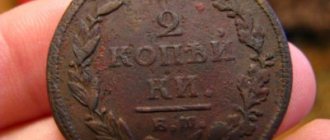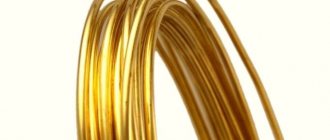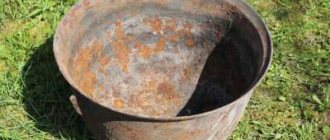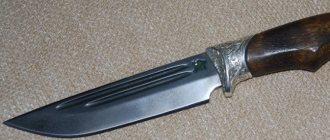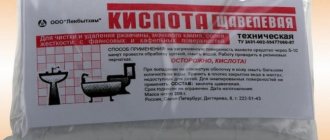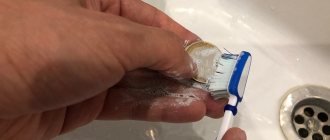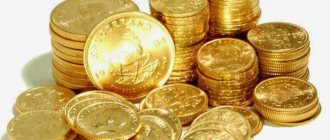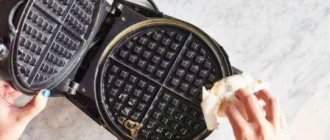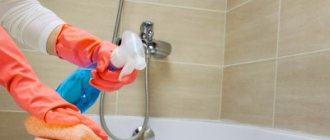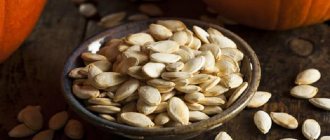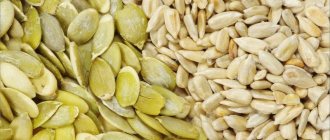Coins are a favorite material for collectors. Of course, zinc coins are not the best option for creating a collection, but they can still be found among historical treasures both in the hands of private collectors and large companies.
Most often, not pure zinc was used in the production of such coins. It was combined with other metals - iron, copper or tin. Coins made from zinc have a "short life" as they are exposed to the environment, causing them to develop dark spots and become dull. Therefore, if you want to return your coins to their former beauty and shine, we offer a few tips that will help you quickly get them in order.
Cleaning iron and zinc coins
Soviet coins were often made of iron and zinc. Working with such material is not difficult. To work, you will need hydrochloric acid, previously diluted with water. The product is used for preliminary washing; the plaque is directly removed with a brush, the bristles of which are made of brass wire.
Rust can be removed with a knife; to get the usual shine, rub the product with a piece of dense fabric. When working with hydrochloric acid, it is important to maintain proportions. If you take too concentrated a composition, the old drawing will simply come off or be damaged. After treatment with a saline solution, it is imperative to rinse in soapy water and wipe dry with a soft cloth.
How to clean copper coins
Copper coins are among the most “capricious” in terms of cleaning. Copper easily reacts with potent substances, which can cause irreparable harm to the specimen.
The situation is aggravated by the relative rarity of such banknotes - a novice numismatist simply has nothing to conduct experiments on in order to test this or that method from personal experience.
The safest ways to clean copper coins are:
- soaking in a soapy solution is a long and labor-intensive process that can take several weeks or even months;
- cooking in oil (vaseline, olive);
- cooking in soda solution.
The following methods are only possible if other options do not give the desired result. They must be used with extreme caution, because... there is a high chance of washing away the patina, corroding deep cavities and making any flaws more obvious.
- Citric acid is a powerful reagent that can destroy copper in a matter of minutes and is effective in combating copper chloride (green deposits or stains).
- Ammonia quickly removes cuprous oxide (reddish deposits).
- Electrolysis is not suitable if there is any damage on the coin.
- Vinegar damages the relief and patina on the coin and opens cavities. It is used to combat the yellowish tint of patina - a coating of lead carbonate.
- Trilon B cleans coins well with a uniform coating of oxides. With stains of different structures, there is a high risk of getting a “bald” result.
After treating the coin with any of the proposed means, additional mechanical manipulations are carried out - cleaned with a soft toothbrush, wiped with a natural cloth.
Lead, tin and aluminum
To clean lead, tin or aluminum coins, avoid using chemicals. If the dirt does not form huge stains, you can remove it using a glass brush. In this case, the coins need to be rubbed well on cloth or felt. After cleaning, regardless of the metal used in the alloy, you need to thoroughly rinse the product, first with warm and then with cool water. This will prevent recurrence of damage and the coin will look beautiful.
Methods for cleaning bimetallic coins
The center of such products is made of cupronickel, and the outer ring is made of brass. Cleaning is challenging as metals require different handling.
Read more ► How and with what to wash stainless steel dishes at home: folk methods and purchased products
The best options suitable for both parts may be:
- Soap. Use is similar to removing patina.
- Dishwashing gel. About 30 ml of gel should be poured into a liter of warm water and the product should be left in it for 0.5-1 hour. Then you need to rinse them and wipe them with a flannel cloth.
- Lemon acid . One glass of cool water will require 3 g of powder. Bimetallic coins must be soaked, contact time is 0.5-1 minute. When finished, rub with a soft cloth to add shine to the products.
- Soda. It is necessary to dilute 50 g of powder in 250 ml of boiling water, dip the coins for 20 minutes. If the dirt is very heavy, you can clean the metals with toothpaste, but cleaning may cause scratches.
- Ammonia. Ammonia should be poured into a shallow container, the product should be placed in the liquid for 5-10 seconds, then rinsed and polished.
Soda
If you decide to use soda, then first soak the coin in a weak vinegar solution or lemon juice solution. It takes 15-20 minutes to stand it. Next, mix baking soda with water until you get a paste. Using your fingers, rub the pulp over each coin, tracking how the dirt goes away. This way of caring for your silver will not only get rid of impurities, but will also begin to shine beautifully. This method is only suitable for non-valuable items in your collection, since the abrasiveness of soda leaves micro-scratches, which affects the final cost.
How to clean silver coins
Silver, compared to copper or bronze, is a less active metal, so it reacts reluctantly with cleaning agents. Therefore, there is less chance of damage to the rarity due to improper care.
When choosing the appropriate method, the metal sample and the degree of contamination should be taken into account. High-grade coins are cleaned with a mixture of toothpaste, ammonia and baking soda. On specimens with low purity, a green coating is often found due to the oxidation of copper impurities. It can be removed with ammonia or Trilon B solution. A weak solution of sulfuric or citric acid is also used.
Professional restorers use the drug Silberpflege (Silbertauschbader) when working with silver of at least 625 standard.
Soda solution for silver
Baking soda is the most popular cleaning agent for silver pieces. There are 2 methods described on the Internet:
- Add a few drops of water to the soda until a paste forms, which is used to rub the coins until they are completely clean. This method is only good for low-quality specimens, because... even finely dispersed paste can leave microtraumas on the metal surface.
- Prepare a solution from a glass of hot water, 2 tbsp. baking soda and a few drops of dishwashing detergent. The coins are soaked in the solution for about 8 hours, then wiped and dried.
Sulfuric acid
If a bright green coating has formed on the surface, then for cleaning it is better to give preference to a low concentration sulfuric acid solution. To work, you will need a porcelain cup into which the coin is placed and filled with solution. After preliminary softening of the plaque, remove the coin and remove dirt with a soft brush, rinsing with tap water. If the acid solution is preheated, the process will speed up. Do not forget about safety precautions when working with acid solution.
How to clean a black coin?
Time is one of the few causes of blackness. In this article we will tell you how to clean dirt from exhibits. Over time, the top layer of copper oxidizes as a result of contact with air, which is why a special coating appears on the surface - patina. It looks like a black coating, which can be difficult to get rid of even for an experienced restorer.
However, there are a few tricks that can help get rid of this problem. Alternatively, the coin can be wiped with a cotton pad soaked in ammonia, followed by rinsing in a warm soapy solution. The main component of this alcohol is ammonia, which, due to its properties, reacts well with copper oxide compounds.
There is another way to clean a copper surface - a mixture of oxalic acid, turpentine, ethyl alcohol and water. This mixture can both clean dirt and degrease and remove metal oxide.
Limonka
A solution of lemon juice of low concentration will serve a good purpose in the process of washing silver. The coin is placed in the solution and gradually turns over. When the dirt begins to peel off, rub the items with a soft cloth. If the dirt is not completely removed, use the procedure again. It is important not to leave the coin unattended for a long time. It may lose its natural color.
Year of manufacture and material of manufacture
In 1991, the time came to issue new money in denominations of 10, 50 kopecks and 1, 5 and 10 rubles, but from other metals. Let's deal with this now.
1961 coin issue:
- for the production of coins from 1 to 5 kopecks, copper-zinc alloy metal was chosen;
coins in denominations from 10 to 50 kopecks. and 1 ruble - from nickel.
Money issued in 1991:
- in denominations of 10, 50 kopecks and 1, 5 and 10 rubles were made of alloys (10 kopeck coin - steel treated with brass; 50 kopeck coin - copper-nickel alloy);
- 1, 5 and 10 rubles are made of a compound of two metals (the central part is made of a copper-zinc alloy; the outer ring is made of a copper-nickel alloy).
Ammonia
An even easier way to get rid of stains is ammonia. It does an excellent job of removing greens and other compound deposits. It takes no more than 60 seconds to hold the coin in it. Rub the coin with a cloth for about the same amount of time, which will remove deposits that are not naturally expected. If a minute is not enough for cleaning, the procedure is repeated. If the oxides are still not removed from the coin, you cannot do without abrasive means, although numismatists do not recommend this method. Most collectors prefer Silbertauschbader. However, it can be difficult to obtain, but you can order it online.
How to clean aluminum bronze coins
For aluminum bronze fines, the following processing is acceptable:
- electrolysis,
- ammonia,
- Trilon B solution.
With such methods, interaction with the metal itself is minimal, so the coin does not collapse or change its color.
But the aluminum bronze alloy is sensitive to the effects of any acids. Abrasive cleaning is also contraindicated.
Inexperienced collectors strive to literally polish their coins until they shine, but the patina gives the coins special value and indicates their authenticity. You can restore it after aggressive cleaning using a thin layer of iodine or naturally by leaving the coins in the sun for about a year.
Nickel coins
The nickel version of coins gets rid of green oxides using a soap solution, but it will not cope with red ones. The most commonly used solution for cleaning nickel coins is acetic acid. Since this product is an aggressive environment, the disadvantage of this cleaning method will be damage to the surface layer of the coin. Typically the result is a large number of small cavities. However, compared to a red-brown coin, which looks completely unnatural, one cleaned with vinegar looks nicer.
To get the job done, just use table vinegar. The products are placed with tweezers for several minutes and washed with tap water. To remove pinkish stains, you can rub with salt. However, do not forget about the abrasiveness of the product, which means the appearance of small scratches.
To work, you will need 50 grams of table vinegar and a teaspoon of table salt.
The mixture is thoroughly mixed; the salt does not need to be completely dissolved. During this cleaning, coins are placed on salt, which will fall out as sediment, and are turned over every two to five minutes. Depending on how much the coins have oxidized, it will take up to 20 minutes.
How to clean cupronickel coins
Cupronickel silver coins, also known as copper-zinc coins, are very difficult to clean. Due to the copper content, the alloy tends to turn treacherously red, especially when exposed to acids.
A soap solution will help wash away surface dirt. It is better to entrust more persistent stains to a professional or risk cleaning with a vinegar solution (1:10 with water).
There is a method that the modern generation inherited from Soviet housewives, who brought nickel silver cutlery into proper shape using soda, foil and boiling water:
- The bottom of the enamel container is lined with foil.
- The foil is covered with soda in an even layer of 2-3 mm.
- Coins are placed on the soda and covered with soda again.
- Pour boiling water over everything and cover with a lid.
- After 12 hours, the coins are washed, cleaned with a soft brush and soap or dishwashing detergent.
The procedure is repeated if desired. It is better not to use this method on damaged copies.
Paste GOI
GOI paste can help in the fight against complex stains. However, this method is undesirable, and as for rare and valuable items, it is completely unacceptable. However, inexpensive coins with its help acquire a chic shine. Therefore, this method is only suitable for products that you do not plan to sell.
The action of GOI paste is based on an abrasive composition. By and large, the same as in the process of cleaning with soda, but the composition is more professional, so cleaning is carried out much faster. If coins are poorly preserved and have small relief, which is important, abrasive methods should be abandoned, as you can completely lose it.
How to clean rust on a coin?
Each collector has his own secrets for cleaning coins from rust and other contaminants. Each metal has a unique chemical composition, so you need to know what can and cannot be used to restore these valuables.
To clean a coin from rust you can use:
- vinegar;
- citric acid/juice;
- soda;
- coca cola;
- salt;
- laundry soap.
Use all these means by analogy with the above methods.
How to clean the green deposits on a coin?
There are times when you don’t know how to clean oxidation on a coin. After all, oxidized coins lose their original, marketable appearance. The method of cleaning depends greatly on the type of alloy itself, so you should carefully determine what type of corrosion has affected the metal.
There are many types of corrosion, the most common of which are:
- green spots—oxidized copper surface. Formed as a result of prolonged exposure to a damp and damp environment;
- a reddish coating, most often found on coins that were in a poorly ventilated space;
- The black color of the metal is a patina, indicating the great age of the metal.
There are several ways to get rid of the green coating. One of the safest is cleaning with a solution of diluted vinegar. To prepare it, you need to take two tablespoons of food vinegar and a liter of clean water (ideally distilled). After this, you should place the coins in this liquid so that they are not in contact with other surfaces and have the smallest area of contact with the walls of the container in which they are placed. This is necessary to ensure that the entire surface of the coin is evenly exposed to the acid.
Details
Ways to clean coins at home
Once we know what the coins were made of in those days, we can choose a method for cleaning and polishing them. There are many ways to clean coins at home, but each metal and alloy must be cleaned in a certain way.
REFERENCE! Otherwise, you can damage the coin or even destroy it.
Soap solution
You can save copper coins from the times of the USSR using ordinary soap. A coin cleaner in the form of a weak soap solution can restore them. It can slowly remove rust and dirt. It can also be used to easily remove oxides from a coin with a toothbrush. The consistency of the soap solution should be similar to kefir. Coins should be placed in the prepared solution and left for 3-4 days, turning them over periodically. After a few days, the coins should be cleaned with a brush and washed in a soda solution to remove any remaining soap. The disadvantage of this method is that it takes a long time.
Ammonia or citric acid
Before you put coins in ammonia or citric acid, you should know that the effect of these solutions on metals is quite strong. They are capable of dissolving a copper coin in a short amount of time. This method can be used to clean silver items. For copper coins, this method can be used if they have heavily oxidized areas. However, coins should be immersed in the solution for a short period of time and washed under running water. If the effect was not achieved the first time, the procedure can be repeated.
What solution should I use to clean coins? Vinegar solution
This one is very convenient because vinegar is available in almost every home. Vinegar can help clean coins. It copes with this task because it dissolves salts perfectly. When exposed to vinegar, not only oxides disappear, but also patina. For this reason, this cleaning method must be carried out carefully, otherwise the coin may be damaged.
REFERENCE! You also need to know that when using a vinegar solution, a rusty tint will appear on the surface of copper-nickel alloy coins.
How to properly clean coins with Coca-Cola
After advertising for this carbonated drink appeared, ways to use it in the household appeared. To clean coins with cola, you need to put the coins in a container of soda and leave them there for 10-12 hours. After this time, the coins must be removed and washed under running water. Then you need to rub the coins with a soft cloth to make them shine.
Kefir
Kefir or ayran contains a small amount of lactic acid. This method is suitable for cleaning brass, bronze and aluminum coins. You can get a good effect if you leave coins in this drink for 2-3 months. From time to time, the solution must be periodically changed and stirred.
Olive oil
The essence of this method is to process coins in boiling oil. This method cleans bronze and copper coins well. Aluminum coins cannot be processed in this way, as the metal will melt from such exposure.
REFERENCE! The main advantage of this method is the preservation of patina.
Electrolysis
Exposure to electric current is suitable for use at home. You need to attach a coin to one end (with a negative charge), and any metal plate to the other. All this must be placed in an electrolyte and current must be passed from any power supply. Electrolyte can be obtained by dissolving 2-3 tablespoons in 1 liter of water. soda or salt.
The duration of the procedure should be 15-20 minutes. Coins, which are made of aluminum bronze, react perfectly to any acid, so you can ruin it in just a few seconds. Collectors often use a softened solution, making it from two tablespoons of vinegar per glass of water. The result is not an acid, but a weak solution of it, which does not have such a strong effect on coins. The treatment is carried out 1-3 times until the desired result is obtained, and then rubbed with paste to form a natural shine.
Useful tips
When processing coins, the appearance, which is valued in the collecting community, often deteriorates, so it is restored using a special method: placing the coin in a 10% hyposulfite solution for 10-15 minutes.
After this treatment, the coin looks very natural and the material is not subject to corrosion. Under no circumstances should you use GOI paste or other similar pastes: they negatively affect the surface, remove patina, and get clogged into the small contours of the product.
Source
Soap solution and citric acid
The easiest way to clean a coin is a mixture of laundry soap and warm water. These ingredients are found in every home. In order to prepare the solution, you need to grate a bar of soap and add it to heated water.
After soaking, you need to rinse the money under running liquid and wipe dry with a soft cloth. You can use a sponge to wash dishes. It is not recommended to use hard fabrics. This method is used to clean royal coins and items from the Soviet period.
If the recipe is not followed, or if it is left in an acid-base environment, the patina and the metal itself can be damaged. All methods must be applied competently. The citric acid cleaning method is very effective, but can affect the surface structure and cause its deformation.
You must strictly adhere to the recipe. To create a solution, take 4 tablespoons of citric acid and 10 tablespoons of water. It is not recommended to add more acid, because the concentration will be more intense and can cause harm.
Money is placed in this composition for 5 minutes. For old stains, increase the time to 10 minutes. During this time, the dirt will disappear and thus will not damage the structure of the copper. Repeat if necessary.
Don't worry if a pink tint appears. In a few weeks it will disappear. Citric acid will help cope with the green coating that appears as a result of oxidation under prolonged exposure to moisture.
To come in
Already registered? Sign in here.
New messages in topics
Help determine authenticity. Thank you 1 2 3 4 5
Author: Danil001, 02.11.2021 12:29 in Main forum
- 106 replies
- 1,684 views
- Danil001
- 03.11.2021 21:00
- Author: Bugbaidych, 10/14/2021 09:11 in XP
- 92 replies
2
- Bugbaidych
- 03.11.2021 20:55
Symptoms of coronavirus, life during the pandemic and after covid.. 1 2 3 4 219
Author: rapid
, 03/18/2020 03:45 in Fludilka
- 5,464 replies
177,493 views
- canopus
- 03.11.2021 20:46
The topic is about everything, and especially about whining and complaining in order to 1 2 3 4 556
Author: Horst
, 05/06/2018 16:03 in Fludilka
- 13,882 replies
322,773 views
- Niver
- 03.11.2021 20:46
Cop 39rus. 1 2 3 4 11
Author: den7109, 11/27/2019 11:18 am in Reports from the cop
- 257 replies
31,161 views
- Niver
- 03.11.2021 20:22
Finds from Dm86 1 2 3 4 6
Author: Dm86, 13.10.2020 16:49 in Reports from the cop
- 144 replies
9
- Karbofoss
- 03.11.2021 20:02
Bottle
Author: Derevnya23, 03.11.2021 19:44 in Cost estimation
- 0 replies
21 views
- Village23
- 03.11.2021 19:44
Item identification
Author: Ekaterina183, 03.11.2021 17:25 in Identification
- 1 answer
64 views
- protégé
- 03.11.2021 18:56
Painting for evaluation
Author: cjnybr, 03.11.2021 07:33 in Cost estimation
- 3 answers
- Stan7
- 03.11.2021 18:32
Signet ring (fragment)
Author: Ekaterina183, 03.11.2021 16:50 in General forum on finds
Source
